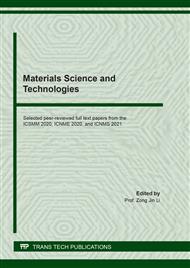p.49
p.56
p.62
p.68
p.77
p.83
p.89
p.99
p.105
Characterization of Cellulose Acetate Based Scaffolds Derived from Kapok Fiber (Ceiba pentandra (L) Gaertn)
Abstract:
Utilization of natural biopolymers has shown potential in generating innovations for tissue engineering applications. This study aims to fabricate scaffolds from cellulose acetate derived from kapok fiber. Cellulose is extracted from raw kapok fibers by alkali treatment and delignification then synthesized into cellulose acetate. Kapok cellulose acetate (KCA) is dissolved in dimethyl sulfoxide to fabricate the scaffold. Materials were characterized using Attenuated Total Reflectance – Fourier Transform Infrared (ATR-FTIR) spectrometer, X-ray diffractometer (XRD) and Differential Scanning Calorimeter (DSC). FTIR analysis has shown that cellulose was extracted from kapok and cellulose acetate was successfully synthesized. XRD analysis also confirmed the presence of cellulose acetate. Results have also shown that synthesized KCA seems to have higher crystallinity than commercially available cellulose acetate (CCA). The degree of substitution (DS) of KCA was found to be 2.85 which is close to the DS value of tri-substituted cellulose acetate. DSC analysis has shown lower glass transition temperature of 52.15°C but higher degradation temperature of 300.43°C than the CCA. Moreover, the values for the enthalpy of fusion for two endotherms of KCA (44.0556 J/g and 18.6946 J/g) are higher than the values for CCA by 344% and 261%, respectively; thus, indicating the higher degree of crystallinity for synthesized KCA samples.
Info:
Periodical:
Pages:
77-82
Citation:
Online since:
July 2021
Keywords:
Price:
Сopyright:
© 2021 Trans Tech Publications Ltd. All Rights Reserved
Share:
Citation:


